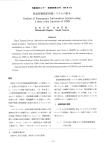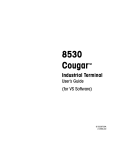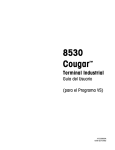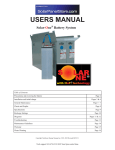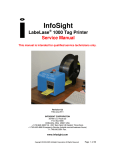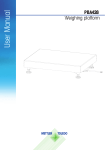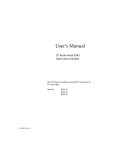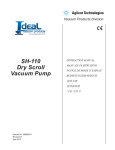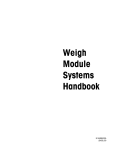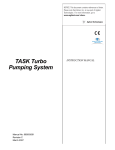Download METTLER TOLEDO (Edit this in File Properties Title) Service Manual
Transcript
SWS315 Load Cell Conversion Kit Installation and Service Manual 17066400A 61070071 (5/12).01 © 2004, 2012 Mettler-Toledo, LLC No part of this manual may be reproduced or transmitted in any form or by any means, electronic or mechanical, including photocopying and recording, for any purpose without the express written permission of METTLER TOLEDO. U.S. Government Restricted Rights: This documentation is furnished with Restricted Rights. METTLER TOLEDO Publication Revision History An overview of this manual’s revision history is compiled below. Publication Name: SWS315 Load Cell Conversion Kit Installation and Service Manual Publication Part Number: 17066400A Part Number Date 17066400A.01 5/12 Publication Date: 1/04 Revisions Changed model number from TLC to SWS315 with SLS510 load cell. EC DECLARATION OF CONFORMITY EC Konformitätserklärung EC Déclaration de conformité EC Declaración de Conformidad EC Conformiteitsverklaring EC Dichiarazione di conformità We/Wir/Nous/Wij/Noi: Mettler-Toledo, Inc., 1150 Dearborn Drive, Worthington, Ohio 43085 USA declare under our sole responsibility that the product, erklären, in alleiniger Verantwortung, daß dieses Produkt, déclarons sous notre seule responsabilité que le produit, declaramos, bajo nuestra sola responsabilidad, que el producto, verklaren onder onze verantwoordelijkheid, dat het product, dichiariamo sotto nostra unica responsabilitá, che il prodotto, Model: Type: Load Cell SLS510 to which this declaration relates is in conformity with the following standard(s) or other normative document(s). auf das sich diese Erklärung bezieht, mit der/den folgenden Norm(en) oder Richtlinie(n) übereinstimmt. Auquel se réfère cette déclaration est conforme à la (aux) norme(s) ou au(x) document(s) normatif(s). Al que se refiere esta declaración es conforme a la(s) norma(s) u otro(s) documento(s) normativo(s). Waarnaar deze verklaring verwijst, aan de volende norm(en) of richtlijn(en) beantwoordt. A cui si riferisce questa dichiarazione è conforme alla/e sequente/i norma/e o documento/i normativo/i. in combination with a weighing terminal produced by Mettler-Toledo is in conformity with the following directives and standards. Council directive on the harmonization of the laws of the Member states: relating to non-automatic weighing instrument (90/384/EEC) amended by directive (93/68/EEC) Relating to equipment and protective systems for use in potentially explosive atmospheres (94/9/EC) standards: Certificate No. (if applicable) EN 45501 (Article 1.2.a.) D09-08.25 EN 60079-0 :2006 FM09ATEX0049X1 EN 60079-11 :2007 II 3 G Ex nL IIC T4 Ta= -20°C to +40°C ; IP67 EN 60079-15 :2005 EN 60079-26 :2007 FM09ATEX0048X2 EN 61241-0 :2006 II 1 G Ex ia IIC T4 Ta= -20°C to +40°C ; IP67 EN 61241-11 :2006 II 1 D Ex iaD T73°C; IP67 EN 60529 :1991 + A1 :2000 Darrell Flocken, Manager – Compliance Services Original Issue: Revised: December 2009 May 2010 According to EN 45014 _________________________ 1 2 Certificate issued by FM Approvals Ltd. 1 Windsor Dials, Windsor, Berkshire, UK SL4 1RS, NB Number 1725 Certificate issued by FM Approvals Ltd. 1 Windsor Dials, Windsor, Berkshire, UK SL4 1RS, NB Number 1725 INTRODUCTION This publication is provided solely as a guide for individuals who have received Technical Training in servicing the METTLER TOLEDO product. Information about METTLER TOLEDO Technical Training can be obtained by writing, calling, or faxing: METTLER TOLEDO 1900 Polaris Parkway Columbus, Ohio 43240 USA Phone: (614) 438-4511 Fax: (614) 438-4958 www.mt.com WARNING! This equipment generates, uses, and can radiate radio frequency energy and if not installed and used properly, i.e., in accordance with the instructions manual, may cause harmful interference to radio communications. It has been tested and found to comply with the limits for a Class A computing device pursuant to Subpart J of Part 15 of FCC Rules, which are designed to provide reasonable protection against such interference when operated in a commercial environment. Operation of this equipment in a residential area is likely to cause interference to radio communications, in which case the user at his own expense will be required to take whatever measures may be required to correct the interference. METTLER TOLEDO RESERVES THE RIGHT TO MAKE REFINEMENTS OR CHANGES WITHOUT NOTICE. Precautions WARNING READ this manual BEFORE operating or servicing this equipment. FOLLOW these instructions carefully. PERMIT ONLY QUALIFIED PERSONNEL TO SERVICE THIS EQUIPMENT. EXERCISE CARE WHEN MAKING CHECKS, TESTS, AND ADJUSTMENTS THAT MUST BE MADE WITH POWER ON. FAILING TO OBSERVE THESE PRECAUTIONS CAN RESULT IN BODILY HARM. WARNING FOR CONTINUED PROTECTION AGAINST SHOCK HAZARD, CONNECT TO PROPERLY GROUNDED OUTLET ONLY. DO NOT REMOVE THE GROUND PRONG. SAVE this manual for future reference. WARNING DO NOT allow untrained personnel to operate, clean, inspect, maintain, service, or tamper with this equipment. DISCONNECT ALL POWER TO THIS UNIT BEFORE INSTALLING, SERVICING, CLEANING, OR REMOVING THE FUSE. FAILURE TO DO SO COULD RESULT IN BODILY HARM AND/OR PROPERTY DAMAGE. CAUTION ALWAYS DISCONNECT this equipment from the power source before cleaning or performing maintenance. BEFORE CONNECTING/DISCONNECTING ANY INTERNAL ELECTRONIC COMPONENTS OR INTERCONNECTING WIRING BETWEEN ELECTRONIC EQUIPMENT, ALWAYS REMOVE POWER AND WAIT AT LEAST 30 SECONDS. FAILURE TO OBSERVE THESE PRECAUTIONS COULD RESULT IN BODILY HARM OR DAMAGE TO OR DESTRUCTION OF THE EQUIPMENT. CAUTION CALL METTLER TOLEDO for parts, information, and service. OBSERVE PRECAUTIONS FOR HANDLING ELECTROSTATIC SENSITIVE DEVICES. WARNING BLOCK THE LEVER SYSTEM SECURELY DURING INSTALLATION TO PROTECT THE EQUIPMENT AND PERSONS WORKING IN THE AREA. FAILURE TO DO SO COULD RESULT IN BODILY HARM OR PROPERTY DAMAGE. Disposal of Electrical and Electronic Equipment In conformance with the European Directive 2002/96 EC on Waste Electrical and Electronic Equipment (WEEE) this device may not be disposed of in domestic waste. This also applies to countries outside the EU, per their specific requirements. Please dispose of this product in accordance with local regulations at the collecting point specified for electrical and electronic equipment. If you have any questions, please contact the responsible authority or the distributor from which you purchased this device. Should this device be passed on to other parties (for private or professional use), the content of this regulation must also be related. Thank you for your contribution to environmental protection. CONTENTS 1 Introduction ............................................................................................... 1-1 Tension Load Cell Conversion Kit ...................................................................................... 1-1 Model Number ................................................................................................................ 1-2 Power Supply Requirements ............................................................................................. 1-2 Load Cell Specifications .................................................................................................. 1-3 Approvals ....................................................................................................................... 1-3 Dimensions .................................................................................................................... 1-4 2 Size the Load Cell ...................................................................................... 2-1 Procedure ...................................................................................................................... 2-1 Sizing Tips .........................................................................................................................2-1 3 Plan the Conversion.................................................................................... 3-1 Locate the Load Cell ........................................................................................................ 3-1 4 Installation ................................................................................................ 4-1 Block the Levers.............................................................................................................. 4-1 Remove the Steelyard Rod ............................................................................................... 4-3 Assemble the Rod and Load Cell ....................................................................................... 4-3 Install Steelyard Rod and Load Cell Assembly .................................................................... 4-5 Secure the Load Cell Cable .............................................................................................. 4-5 Connect the Load Cell Cable ............................................................................................ 4-6 5 Calibration ................................................................................................ 5-1 Calibrate the Scale ......................................................................................................... 5-1 6 Troubleshooting ......................................................................................... 6-1 General .......................................................................................................................... 6-1 Isolate the Problem ......................................................................................................... 6-1 Check Mechanical Components ........................................................................................ 6-2 Check Wiring .................................................................................................................. 6-2 Check Load Cells ............................................................................................................ 6-3 Chapter 1: Introduction Tension Load Cell Conversion Kit 1 Introduction Tension Load Cell Conversion Kit The SWS315 tension load cell conversion kit is used to convert a mechanical scale for electronic operation. Each kit includes a tension-mount load cell with an integral cable and the mounting hardware needed to install the load cell. The kit is designed for installation in the steelyard of an existing mechanical dial scale. Installation involves removing the appropriate length of steelyard rod and then replacing the length that was removed with the load cell assembly. Make sure that the mechanical scale’s dial, cabinet, and lever suspension system are in good operating condition. It is important to note that the electronic indicator and the mechanical dial cannot be used simultaneously. When the electronic indicator is being used, the dial head must be locked (mechanically grounded). When the mechanical dial is being used, the electronic indicator will not display an accurate weight reading. Figure 1-1: Mechanical Scale Conversion This manual explains how to install and service an SWS315 tension load cell conversion kit. If any information is incorrect or missing from the manual, please use the Publication Suggestion Report at the back of the manual to tell us about it. NOTE: This manual does not explain how to use the load cells to install a suspended tank or hopper scale. Do not use this manual to install a suspended system. (5/12) 1-1 METTLER TOLEDO SWS315 Load Cell Conversion Kit Installation and Service Manual Model Number SWS315 load cell conversion kits are available in capacities ranging from 50 lb to 2,000 lb. All load cells are dual-labeled as NIST Class III 5000d (for general purpose “commercial” applications) and NIST Class IIIL 10,000d (for vehicle scale applications). SWS315 Kit Item Number Load Cell Capacity Load Cell Item Number NIST H-44 Accuracy Class Load Cell Thread Size Cable Length Shipping Weight 61042059 50 lb 61040268 III/5000d IIIL/10,000d 1/4-28 UNF 20 feet 5 lb 61042060 100 lb 61040269 III/5000d IIIL/10,000d 1/4-28 UNF 20 feet 5 lb 61042061 200 lb 61040270 III/5000d IIIL/10,000d 1/4-28 UNF 20 feet 5 lb 61042062 500 lb 61040272 III/5000d IIIL/10,000d 1/2-20 UNF 20 feet 5 lb 61042063 1,000 lb 61040274 III/5000d IIIL/10,000d 1/2-20 UNF 20 feet 5 lb 61042064 2,000 lb 61040276 III/5000d IIIL/10,000d 1/2-20 UNF 20 feet 5 lb Table 1-1: Load Cell Configuration Power Supply Requirements A METTLER TOLEDO digital indicator is used to power the analog load cells. Refer to the digital indicator’s service manual for the indicator’s power requirements. 1-2 (5/12) Chapter 1: Introduction Load Cell Specifications Load Cell Specifications Model: SLS510 Rated Capacity (R.C.): 50 to 2,000 lb Rated output: 3.0 mV/V ± 0.25% Maximum excitation voltage: 18 VDC Input terminal resistance: 430 ohms ± 60 ohms Output terminal resistance: 351 ohms ± 2 ohms Material: Stainless steel Sealing: Environmentally protected (potted), IP67 Temperature range (compensated): -10°C to +40°C (+14°F to +104°F) Safe side load: 30% of R.C. Safe overload: 150% of R.C. Zero balance: 1.0% of R.C. (maximum) Approvals NTEP Certification Model SLS510 load cells meet or exceed NIST Handbook-44 requirements for Class III 5000 divisions and Class IIIL 10,000 divisions. A certificate of conformance was issued under the National Type Evaluation Program (NTEP) of the National Conference of Weights and Measures (certificate number 11-020). (5/12) 1-3 METTLER TOLEDO SWS315 Load Cell Conversion Kit Installation and Service Manual Dimensions D B A C E Load Cell Capacity A B C D E 50-200 lb 1/4-28 UNF 0.59 inch (14.9 mm) 0.46 inch (11.7 mm) 2.00 inches (50.8 mm) 2.40 inches (61.0 mm) 500-1,000 lb 1/2-20 UNF 0.84 inch (21.3 mm) 0.71 inch (18.0 mm) 2.00 inches (50.8 mm) 2.40 inches (61.0 mm) 2,000 lb 1/2-20 UNF 1.09 inches (27.7 mm) 0.96 inch (24.4 mm) 2.00 inches (50.8 mm) 2.40 inches (61.0 mm) Table 1-2: Load Cell Dimensions 1-4 (5/12) Chapter 2: Size the Load Cell Procedure 2 Size the Load Cell Procedure Use the following procedure to determine what size load cell to install: 1. Determine the initial pull (the pull of the levers plus the deadweight of the platform divided by the scale multiple). 2. Determine the capacity of the scale. 3. Determine the multiple of the lever system. 4. Insert those three variables in the following formula to determine the required load cell size: Load Cell Size = Initial Pull + 5. Capacity Multiple Choose a tension load cell conversion kit that contains a load cell closest to the calculated size (but not a lower capacity). Sizing Tips Initial Pull One way to determine the initial pull is to use a lever to raise the steelyard rod. Attach a lifting point, such as a clamp, to the steelyard rod and make sure it is tightened securely. Calculate the weight by using a multiplier based on the position of the fulcrum. For example, if the fulcrum is 2 inches from the end of the lever that is placed under the lifting point and 20 inches from the opposite end, multiply the load used to raise the steelyard rod by 10 to determine the weight of the platform (see Figure 2-1). Capacity The capacity of the scale should be marked on the scale’s data plate. Multiple You can determine the multiple of a lever system by attaching a known test weight to the steelyard rod of the empty scale. The multiple will be the weight change shown on the dial divided by the test weight. For example, if the weight change on the dial is 2,000 lb for a 5-lb test weight, then the multiple would be 400. (5/12) 2-1 METTLER TOLEDO SWS315 Load Cell Conversion Kit Installation and Service Manual 2" 20" Steelyard Rod Clamp Lever Floor Figure 2-1: Using a Lever to Lift the Scale Platform 2-2 (5/12) Chapter 3: Plan the Conversion Locate the Load Cell 3 Plan the Conversion Locate the Load Cell Determine the best location for the load cell. When the scale is used as a mechanical system, the steelyard rod will move as weight is added to or removed from the scale. So you will need to position the load cell where it will have adequate clearance and where the cable can be routed to form a loop that will not interfere with the movement of the steelyard rod or mechanical dial (see Figure 3-1). Loop 5"-6" dia. Figure 3-1: Load Cell Installation Measure the steelyard rod and mark where it will be cut. Be sure to allow for the full movement of the rod when the mechanical scale is used. The length of the steelyard rod is important to the calibration of the mechanical scale, and it should be measured carefully. Figure 3-2 shows the length of the rod to be cut out. If the rod has a 1/2-13 thread, use the load cell assembly only (the assembly consists of the load cell and factory-installed adapters). If the rod has a 3/8-16 or 5/16-18 thread, use the load cell assembly plus optional adapters. (5/12) 3-1 METTLER TOLEDO SWS315 Load Cell Conversion Kit Installation and Service Manual Steelyard Rod Load Cell Assembly 3.75" to 4" Length to be cut from steelyard rod (load cell assembly only: 1/2-13) Steelyard Rod Adapter Load Cell Assembly 6" to 6.25" Length to be cut from steelyard rod (with adapters: 3/8-16 or 5/16-18) Adapter Figure 3-2: Length to be Cut from Steelyard NOTE: For overhead systems with upward pull at the main lever tip (or nose iron), the load cell should be positioned in the steelyard rod between the nose iron and bench lever. 3-2 (5/12) Chapter 4: Installation Block the Levers 4 Installation Block the Levers Block the lever system safely and securely before you remove the steelyard rod. Work carefully, making safety the most important factor in the installation. Keep hands and clothing away from pinch points and moving parts. WARNING BLOCK THE LEVER SYSTEM SECURELY DURING INSTALLATION TO PROTECT THE EQUIPMENT AND PERSONS WORKING IN THE AREA. FAILURE TO DO SO COULD RESULT IN BODILY HARM OR PROPERTY DAMAGE. Levers with Downward Forces If the pull direction at the main lever’s nose iron is downward, use the following procedure to block the lever: 1. Remove all weight from the platform or all material from the tank or hopper. 2. Before removing the steelyard rod, block the lever so that there is no load on the steelyard rod. Use a sturdy material such as hardwood for blocking the lever. For smaller scales (such as bench and portable scales), raise the tip or small end of the main lever by hand and place a block under the main lever near the nose iron. The block should support the main lever so that all load is off the steelyard rod, and it should keep the main lever from moving side to side (see Figure 4-1). Hardwood Blocking Figure 4-1: Blocking Smaller Scales (5/12) 4-1 METTLER TOLEDO SWS315 Load Cell Conversion Kit Installation and Service Manual For larger scales (such as floor and truck scales), you might need to use a hydraulic jack to raise the tip end of the main lever(s). Once each main lever is raised, place a block under it near the nose iron (see Figure 4-2). Jack Hardwood Blocking Figure 4-2: Blocking Larger Scales Levers with Upward Forces For overhead systems where the levers are higher than the mechanical dial, the pull direction at the nose iron is upward. Use the following procedure to secure the main lever at the nose iron to prevent the lever from moving upward: 1. Remove all weight from the platform or all material from the tank or hopper. 2. Pull the main lever down at the nose iron to remove the upward force from the steelyard rod. Use a load-removing mechanism such as a lever hoist or comealong. 3. Once the load is removed from the main lever, use chains, wire rope, or a load binder to secure the lever’s nose iron to anchor points that are capable of supporting the load (see Figure 4-3). Load-Removing Mechanism Securing Line Anchor Point Figure 4-3: Blocking Overhead Systems The blocking/securing line should be independent of the load-removing mechanism. The purpose of the blocking/securing line is to lock the main lever in place safely and securely. Make sure that it cannot be dislodged or removed accidentally. Both the loadremoving mechanism and the blocking/securing line must be rated equal to or greater than the load at the nose iron. 4-2 (5/12) Chapter 4: Installation Remove the Steelyard Rod Remove the Steelyard Rod 1. After the lever system is blocked and the weight is removed from the steelyard rod, carefully disconnect the steelyard rod and remove it. Note the position of the steelyard rod. You will need to re-install it in the same position later. 2. Cut the existing steelyard rod to remove the section that will be replaced by the load cell assembly (see Figure 4-4). Refer to Chapter 3 to determine the length of rod that needs to be removed. 3. Thread the ends of the rod that will be screwed into the load cell adapters. NOTE: As an alternative, you can use a fully threaded steel rod in place of the existing steelyard rod. Steelyard Rod Load Cell Assembly Length to be cut from Steelyard Rod Figure 4-4: Cut the Steelyard Rod Assemble the Rod and Load Cell The load cell is supplied with two factory-installed adapters for connecting to 1/2-13 threaded rods. The adapters are locked in place and must not be removed from the load cell. Attempting to remove the adapters can damage the load cell and will void the warranty. The conversion kit includes optional adapters for connecting to 3/8-16 and 5/16-18 threaded rods. The optional adapters will fit into the 1/2-13 threaded holes in the factoryinstalled adapters. CAUTION: Do not apply torque to the load cell. When tightening adapters, nuts, or rods, place the wrenches on the adapters or nuts. Use a 3/4-inch wrench on the factoryinstalled adapter and a 5/8-inch wrench on the 3/8-16 and 5/16-18 adapters. We recommend applying Loctite to the threads when connecting adapters, nuts, and rods. (5/12) 4-3 METTLER TOLEDO SWS315 Load Cell Conversion Kit Installation and Service Manual Steelyard Rod Steelyard Rod (4) Square Nut To Dial (3) Optional Adapter (2) Square Nut (1) Factory-Installed Adapter (1) Factory-Installed Adapter Mechanical “Ground” End Load Cell Load Cell Mechanical “Live” End (1) Factory-Installed Adapter (2) Square Nut (1) Factory-Installed Adapter (3) Optional Adapter To Nose Iron (4) Square Nut Steelyard Rod Steelyard Rod Figure 4-5: Assembled Steelyard Rod and Load Cell Item Size Trade Name Item Number (1) Factory-Installed Adapters 1/4-28 to 1/2-13 1/2-20 to 1/2-13 TA601442 A12304300A 61078829 68004004 1/2-13 R00432050 61073267 1/2-13 to 5/16-18 1/2-13 to 3/8-16 A12307600A A12307700A 68004005 68004006 3/8-16 5/16-18 R00446050 R00468050 61073268 61073269 (2) Square Nuts (3) Optional Adapters (4) Square Nuts Table 4-1: Mounting Hardware NOTE: The mechanical ground and live ends are not marked on the load cell. To determine which end is which, note the position of the load cell cable and refer to Figure 4-5. 4-4 (5/12) 1. If the steelyard rod does not have 1/2-13 threads, install optional adapters that will fit the rod. Screw an optional adapter into each factory-installed adapter. Do not apply torque to the load cell. Instead, use wrenches on the adapters, tightening them by turning the adapters one quarter to one half turn past snug tight. 2. Locate the section of steelyard rod that connects to the dial weight beam, and attach it to the mechanical “ground” end of the load cell assembly. Place a square nut on the threaded rod and screw the end of the rod into the adapter until the rod is bottomed in the adapter. Lock the rod in place by tightening the nut against the adapter. 3. Locate the section of steelyard rod that connects to the nose iron, and attach it to the mechanical “live” end of the load cell assembly. Place a square nut on the threaded rod and screw the end of the rod into the adapter until the rod is bottomed in the adapter. Lock the rod in place by tightening the nut against the adapter. Chapter 4: Installation Install Steelyard Rod and Load Cell Assembly Optional Adapters METTLER TOLEDO can supply optional adapters for 1/4-28 and 5/8-11 threaded rods: Adapter Finish Part Number 1/2-13 to 1/4-28 UNF Zinc Plated 17-4 PH Stainless Steel Contact Factory Contact Factory 1/2-13 to 5/8-11 UNC 17-4 PH Stainless Steel Contact Factory Install Steelyard Rod and Load Cell Assembly Re-install the steelyard rod and load cell assembly in the scale cabinet. Be sure to install the steelyard rod in its original position. All locking devices should be in place. The rods and nuts must not be free to turn. After the steelyard rod has been installed and all connections have been tightened, carefully remove the blocks and any jacks or other devices used to support the levers. Secure the Load Cell Cable Form a loop (about 6 inches in diameter) in the load cell cable so that the cable will not interfere with the movement of the steelyard rod (see Figure 4-6). Secure the cable with the clamps that are supplied. Loop 5"-6" dia. Figure 4-6: Load Cell Cable For overhead systems where the load cell is in the steelyard rod between the nose iron and the bench lever, secure the cable by attaching a clamp to the dial head (locked) or the cabinet body. (5/12) 4-5 METTLER TOLEDO SWS315 Load Cell Conversion Kit Installation and Service Manual Connect the Load Cell Cable Connect the load cell cable to the electronic indicator. The wiring codes for tension loading of the load cell are shown in Table 4-2. Function Wire Color -Signal White +Signal Green +Excitation Red -Excitation Black Shield Bare Table 4-2: Tension Load Cell Wiring Codes 4-6 (5/12) Chapter 5: Calibration Calibrate the Scale 5 Calibration Calibrate the Scale Calibrate the scale according to the instructions in the manual for the electronic indicator that is being used. When calibrating and using the electronic indicator, you must lock the mechanical indicator (the dial) to prevent travel. Dial travel will cause nonlinearity that cannot be compensated for in either the electronic indicator or the load cell. It is possible to unlock the mechanical indicator and use it for weighing. But you will need to recalibrate the scale because the load cell cable and the weight of the load cell affect calibration. The mechanical and electronic indicators cannot be used or calibrated simultaneously. If you switch between mechanical and electronic weighing, you will need to recalibrate the scale each time that you do so. Use test weights to calibrate the scale (for either electronic or mechanical operation). To ensure accuracy over the entire range of operation, use test weights equal to the full capacity of the scale. If test weights equal to the full scale capacity are not available, you can use a combination of test weights and material substitution to apply a full-capacity load to the scale. (5/12) 5-1 Chapter 6: Troubleshooting General 6 Troubleshooting General WARNING PERMIT ONLY QUALIFIED PERSONNEL TO SERVICE THIS EQUIPMENT. EXERCISE CARE WHEN MAKING CHECKS, TESTS, AND ADJUSTMENTS THAT MUST BE MADE WITH POWER ON. FAILING TO OBSERVE THESE PRECAUTIONS CAN RESULT IN BODILY HARM. If a scale is not working properly, find out as much about the problem as possible. Try to determine whether the problem is constant or intermittent. Mechanical and electrical influences can cause malfunctions, so be patient and use sound logic when troubleshooting. Isolate the Problem Determine whether the problem is in the scale or the electronic indicator: 1. Remove power from the system. 2. Disconnect the electronic indicator from the scale, and connect the indicator to a load cell simulator (analog load cell simulators are available from METTLER TOLEDO). 3. Reapply power. If the problem persists, consult the electronic indicator manual for further troubleshooting assistance. 4. If the problem is NOT present with the load cell simulator attached to the indicator, remove power, disconnect the simulator, and reconnect the scale. If the problem persists, continue troubleshooting the scale. (5/12) 6-1 METTLER TOLEDO SWS315 Load Cell Conversion Kit Installation and Service Manual Check Mechanical Components Check all mechanical components to make sure they are not worn, damaged, or binding. Make sure that the mechanical indicator (the dial) is locked. Check the load cell assembly and cable to make sure they are not interfering with the movement of the steelyard rod. Make sure all adapters and nuts on the load cell assembly are tightened. Check Wiring 1. Remove power from the system. 2. Make sure that all wiring connections between the load cell and the electronic indicator are tight and that no insulation material is touching the terminal contacts. 3. Check all cable connections for correct wiring. The wiring color codes are given in Table 6-1. Function Wire Color -Signal White +Signal Green +Excitation Red -Excitation Black Shield Bare Table 6-1: Tension Load Cell Wiring Codes 6-2 (5/12) Chapter 6: Troubleshooting Check Load Cells Check Load Cells 1. Remove power from the system. Fully disconnect each load cell and check for proper input/output resistances (see Table 6-2). Measuring Points Resistance +Exc (Red) to -Exc (Black) 370 to 490 ohms +Signal (Green) to -Signal (White) 349 to 353 ohms Table 6-2: Load Cell Resistance 2. If resistance is within specification, perform a shorted-signal symmetry test. Short the signal leads together and place one multimeter lead on the shorted signals and one lead on the +Excitation wire. Note the resistance value. Remove the lead from the +Excitation wire and place it on the -Excitation wire. The two resistance values should be approximately equal. 3. If the load cells pass the shorted-signal test, reconnect them and reapply power to the scale. Confirm that the proper excitation voltage is reaching the load cells by placing multimeter leads on the excitation positions of each load cell terminal. 4. If proper excitation voltage is reaching the load cells, check the output signal from each cell by disconnecting the signal leads and measuring voltage output. If one cell has a particularly high or low dead-load output, it is suspect. The maximum output possible from any cell is 45 mV at 15 VDC excitation and loaded to gross capacity. 5. If any load cell has an unusual signal, remove all load from that cell. With the power on, measure the output from the suspect load cell. The no-load zero output should be ± 1.0% of the full scale output. For example, if the excitation voltage is 15 VDC, then the full scale output would be 45 mV and the no-load zero output should be within ± 0.45 mV. 6. If a load cell fails any of the above tests, replace it. (5/12) 6-3 METTLER TOLEDO Publication Suggestion Report If you have suggestions concerning this publication, please complete this form and fax it to (614) 841-7295 Publication Name: METTLER TOLEDO TLC Load Cell Conversion Kit Installation and Service Manual Publication Part Number: 17066400A PROBLEM(S) TYPE: DESCRIBE PROBLEM(S): Technical Accuracy Text Completeness Procedure/step Example Explanation What information is missing? Publication Date: 5/12 INTERNAL USE ONLY Illustration Illustration Definition Guideline Feature Other (please explain below) Info. in manual Info. not in manual Clarity What is not clear? Sequence What is not in the right order? Other Comments Use another sheet for additional comments. Your Name: Location: Phone Number: ( ) Fax this completed form to METTLER TOLEDO at (614) 841-7295 Mettler-Toledo, LLC Printed in USA 14981600A METTLER TOLEDO 1900 Polaris Parkway Columbus, Ohio 43240 USA P/N: 17066400A (5/12).01 METTLER TOLEDO® is a registered trademark of the Mettler Toledo Group. © 2012 Mettler-Toledo, LLC Printed in USA 17066400A 61070071




























